8
You are using an out of date browser. It may not display this or other websites correctly.
You should upgrade or use an alternative browser.
You should upgrade or use an alternative browser.
Loves302Chevy
"One test is worth a thousand expert opinions."
That link did not work. But I found this one, which is a great article from the same site: http://www.enginebuildermag.com/2012/10/getting-your-bearings/ Here's a few good clips from the article that apply to my 334 SBC case (I'm not trying to steal this thread):
Barkhaus says that on their bi-metal bearings the IDs are bored so the debris is flushed out instead of being embedded. “That’s one of the real benefits of it,” he says. “The other benefit of bi-metal is the wearability. They will last virtually forever, as long as you keep the oil changed and the engine is run in a fairly normal operating condition.”
Aluminum bearings can last much longer in mild load applications because of the wearability and the hardness of the silicon composite that actually polishes the crankshaft and wipes any nodes or debris out of the way or flushes it out, Barkhaus continues.
Federal-Mogul’s Sturk says there are basic differences in the hardnesses of the two bearings as well as some other differences in strength and embeddability. “In my view, embeddability isn’t really that big of a problem. I think today’s aluminum bi-metal bearings can handle a reasonable amount of debris. But if there are excessive amounts, that’s where the tri-metal bearings are better. The over-plate embeddability allows them to handle debris a bit better. If it’s a reasonable amount, if oil has been properly maintained, I don’t really worry about the aluminum’s embeddability.”
Today’s bimetals contain a mix of other materials such as silicon, which is a hard particle that is added for increased durability. They have tin which is considered a soft face metal that is for the embeddability and conformability aspect, so today’s aluminum bi-metals have alloying elements in them to address those issues. But still, not all alloys are the same.
Other good bearing articles on enginebuildermag.com: http://www.enginebuildermag.com/?s=bearing+clearances
Barkhaus says that on their bi-metal bearings the IDs are bored so the debris is flushed out instead of being embedded. “That’s one of the real benefits of it,” he says. “The other benefit of bi-metal is the wearability. They will last virtually forever, as long as you keep the oil changed and the engine is run in a fairly normal operating condition.”
Aluminum bearings can last much longer in mild load applications because of the wearability and the hardness of the silicon composite that actually polishes the crankshaft and wipes any nodes or debris out of the way or flushes it out, Barkhaus continues.
Federal-Mogul’s Sturk says there are basic differences in the hardnesses of the two bearings as well as some other differences in strength and embeddability. “In my view, embeddability isn’t really that big of a problem. I think today’s aluminum bi-metal bearings can handle a reasonable amount of debris. But if there are excessive amounts, that’s where the tri-metal bearings are better. The over-plate embeddability allows them to handle debris a bit better. If it’s a reasonable amount, if oil has been properly maintained, I don’t really worry about the aluminum’s embeddability.”
Today’s bimetals contain a mix of other materials such as silicon, which is a hard particle that is added for increased durability. They have tin which is considered a soft face metal that is for the embeddability and conformability aspect, so today’s aluminum bi-metals have alloying elements in them to address those issues. But still, not all alloys are the same.
Other good bearing articles on enginebuildermag.com: http://www.enginebuildermag.com/?s=bearing+clearances
8
87vette81big
Guest
My Link works just fine. I tried it just now.
8
87vette81big
Guest
Soft babbit faced Tri Metal Bearings
were used in all Allied WW2 Bomber & Fighter Planes. Those engines seen Ultra High Loads and Pushed past the design limits to WIN & KILL THE ENEMY'S .
LOSING NOT AN OPTION.
ALSO ON BABBIT TRI METAL BEARINGS CAN HOLD UP IN NITROMETHANE DRAG RACING.
ALUMINUM SILICON WON'T
were used in all Allied WW2 Bomber & Fighter Planes. Those engines seen Ultra High Loads and Pushed past the design limits to WIN & KILL THE ENEMY'S .
LOSING NOT AN OPTION.
ALSO ON BABBIT TRI METAL BEARINGS CAN HOLD UP IN NITROMETHANE DRAG RACING.
ALUMINUM SILICON WON'T
the link did not work for me either but I WENT AND FOUND THE REFERRED TO ARTICLE
don,t forget that oil flow rates, and reducing the transmission fluid temp in the lower radiator on cars equipped with an automatic transmission, have a big effect on engine cooling so adding a trans or oil cooler helps engine durability
Loves302Chevy posted these diagrams that will be helpful
READ THROUGH THIS LINKED THREAD
http://garage.grumpysperformance.com/index.php?threads/precision-measuring-tools.1390/#post-52469
https://www.hotrod.com/articles/ccrp-0911-small-block-chevy-oil-pumps/
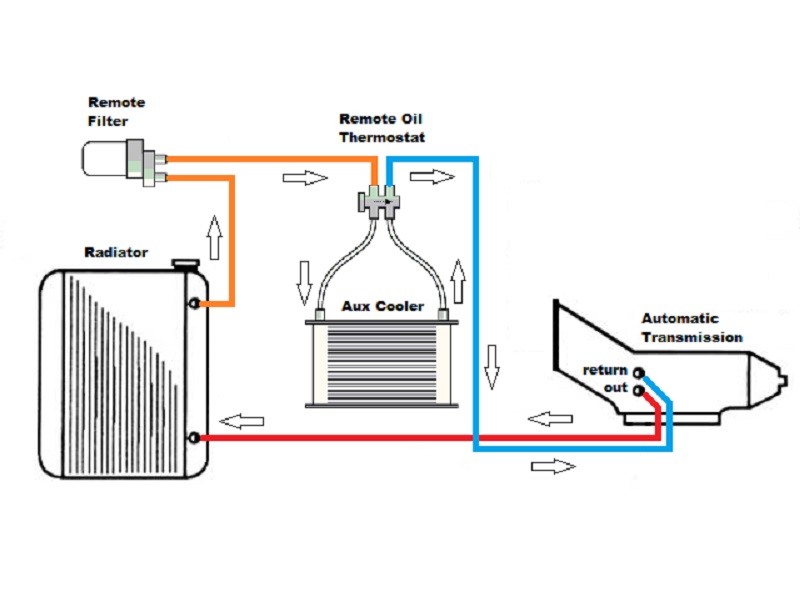
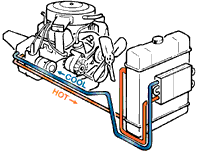
http://garage.grumpysperformance.com/index.php?threads/magnets.120/#post-49772
Engine Bearings Under Pressure
by Larry Carley - Dec 4, 2015
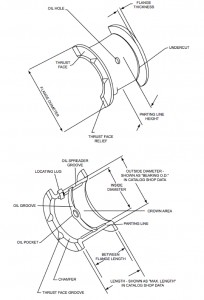
You need to know what you’re talking about when you’re looking at engine bearings. Illustration courtesy of MAHLE Aftermarket.
Engine bearings have to withstand punishing loads in today’s engines. Smaller displacements, turbocharging and higher horsepower ratings mean crankshaft and connecting rod bearings are being subjected to heavier loads. This has led to the development of some new bearing alloys and coatings that enable these parts to survive.
It’s the same story with high performance. Today’s hi-flow, aftermarket, CNC-ported cylinder heads, high lift killer cams and induction system power adders (blowers, turbos and nitrous) are making more power than ever before, and really hammering the bottom end of the engine. If the bearings can’t take it, the engine won’t last.
The stock production aluminum bearings that are used in many late model engines can usually handle up to 500 horsepower before they get into trouble, and over 300 horsepower in a turbocharged four-cylinder engine. But once you get beyond these power levels, bearing fatigue can be a problem. At that point, you have to upgrade to a stronger material of some type, be it a tougher aluminum alloy or a performance tri-metal bearing.
The rod bearings take the most punishment because of the reciprocating motion of the pistons and rods. The load on the rod bearings change with the crank angle and RPM, and whether the cylinder is on its power stroke, compression stroke, intake stroke or exhaust stroke. The upper rod bearings bear the heaviest loads during the power stroke when combustion pressure is ramming the piston and rod down hard against the crank. But the upper rod bearings can also see heavy loads in boosted engines during the compression stroke, and on the exhaust stroke, too – especially in engines that are burning nitrous or nitro. The lower rod bearing can also experience extreme G-forces and loading in a high-revving engine during the exhaust stroke. That’s when most connecting rod and rod bearing failures occur.
The bearings in a stock engine typically had to withstand loads of up to 6,000 PSI or higher depending on the engine’s power output per cubic inch. In a performance engine or a high compression diesel, peak loads can range from 8,500 up to 10,000 PSI or higher.
Bearing manufacturers offer a range of materials with various strength and fatigue resistance ratings to handle every kind of engine application, stock or performance. Some of the better aluminum bimetal alloys (aluminum overlay on a steel shell) can safely handle peak loads of up to 8,000 PSI or higher, while many “race series” tri-metal bearings are good for 10,000 PSI or more. Some specialty bearing materials such as those that have been developed for big, heavy-duty, high output, turbo diesel engines are rated as high as 20,000 PSI. Some of the more exotic bearing materials are applied to the bearing shell using “sputter” or a “PVD” (physical vapor deposition) process in a vacuum-controlled environment. This allows the material to be built up to the desired thickness with a high degree of accuracy.
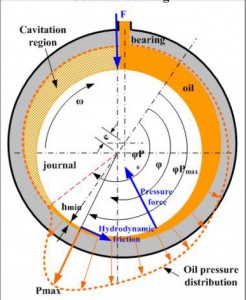
This illustration shows how the oil forms a wedge to lift and lubricate the bearing. The oil film also helps spread the load on the bearing and cushion it against the constant pounding (courtesy of King Bearings).
Alloys And Attitudes
The ideal bearing provides a good combination of durability, fatigue resistance and embedability. Durability means the bearing is strong enough to withstand the peak loads it experiences inside the engine. Fatigue resistance means the bearing won’t crack or flake after millions of engine revolutions and combustion cycles. Embedability means any dirt or wear particles that find their way into the oil film between the bearing surface and crank journal will be pressed into the bearing surface rather than scoring the crank journal.
Engineers today have software that can simulate the loading on a bearing based on an engine’s displacement, bore and stroke, horsepower output, compression ratio and RPM. They can predict how well a given bearing material will hold up in a particular application. So using their software and real world experience, they can recommend a specific type of bearing based on what your requirements are. Are you building a stock motor? A street/strip dual-purpose engine? A petal-to-the-metal drag motor, or truck or tractor puller engine? A circle track or endurance motor? A marine inboard motor?
For most racing applications, you want a bearing that is both durable and fatigue resistant. Drag racing can be really hard on bearings because a relatively cold engine suddenly goes from idle to full throttle for maybe 4 to 12 seconds until the car reaches the end of the strip. The short burst, extreme loading of the bearings means the bearings have to be the right material to withstand the hammering. That’s why tri-metal bearings have traditionally been used in drag motors. But high strength aluminum bearings can also take this kind of short-term abuse, too, according to the manufacturers who make them. In fact, one crankshaft supplier we talked to for another article indicated that aluminum race bearings hold up better in a blown motor than tri-metal bearings.
With a dirt track motor, the engine is going to run a series of laps, alternating between wide open throttle and throttle off. The bearings experience peak loading for a longer period of time when the driver floors the throttle out of the turns. And a feature event usually goes at least 25 or more laps, so durability and fatigue resistance are critical. Tri-metal bearings have traditionally been the bearing of choice for this type of racing. But aluminum performance bearings are also being used in some of these engines.
In a marine application, fatigue resistance is even more important because the engine usually runs flat out for long periods of time. Tri-metal is probably the most common choice here, too.

Construction of various bearing types (courtesy of King Bearing)
Bearing Construction
Tri-metal bearings are made of a copper-lead-tin alloy applied to a steel shell with a thin lead babbit overlay. The babbit overlay provides good seizure resistance. Reducing the thickness of the babbit overlay to .0005 inches is one of the tricks bearing engineers can use to increase fatigue resistance in a performance bearing. A thinner overlay still provides a good bearing surface, but much less embedability. Some tri-metal bearings may also have a hardened surface layer, which improves the load carrying capacity of the bearing.
Aluminum alloy bimetal bearings have been the bearing material of choice for stock production engines because they are long-lived. Aluminum bearings typically have an aluminum-tin-silicon alloy overlay about .012 inches thick on a steel shell. Aluminum alloys can be both strong and soft, providing good strength and embedability. Tin (which may be 6 to 20 percent of the alloy) reduces friction and acts as a solid lubricant. Hard particles of silicon (maybe 2 to 4 percent) may also be added to improve strength and wear resistance. Silicon is essential for engines with cast iron crankshafts to reduce the risk of seizure if the oil film is disrupted. Small amounts of copper, nickel and other elements may also be added to the aluminum alloy to further enhance the properties of the bearing material.
Lubrication Issues
Bearing lubrication is critical from the instant the engine turns over until it is shut down. If a rod or main bearing is starved for oil causing the oil film between the bearing surface and crank journal surface to go away, galling, seizure and failure can occur in an instant.
The babbit top layer on a tri-metal bearing serves as a sacrificial layer when this happens. It can prevent seizure until the babbit wears away. At that point, the situation goes south very rapidly. The bearing usually seizes, locking up the motor or breaking the connecting rod.
With aluminum bimetal bearings, the situation is somewhat different according to tests conducted by one bearing manufacturer. If the oil film between the bearing and crank goes away, there is actually less risk of seizure and failure with their performance bimetal aluminum racing bearing.
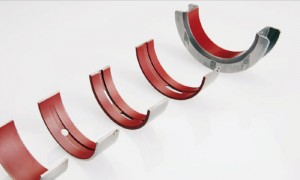
Polyamide coated Irox bearings not only provide added wear protection in Stop/Start engine applications, but also improved fatigue resistance (courtesy of Federal-Mogul).
Coated Bearings
One way engine builders have tried to reduce the danger of engine damage if an engine loses oil pressure during a race is to use coated bearings when they put the engine together. Aftermarket coating suppliers have offered various proprietary coating materials for bearings, pistons and other parts for many years. Only recently have coated bearings become mainstream and readily available from major bearing suppliers. Some bearing suppliers coat their own bearings while others still use an outside vendor to apply the coatings.
Bearing coatings can provide several benefits. They can prevent dry-starts to extend bearing life, as well as provide some degree of protection and seizure resistance if the engine loses oil pressure in a race. Some coatings also have oil retaining properties that help maintain an oil film between the bearing and crank journal. A coating also improves conformability to the crankshaft journal, as well as embedability.
A dry film polymer-based coating will sacrifice itself if the engine loses oil pressure – which can often make the difference between a ruined crankshaft and blown motor or a motor that can be easily rebuilt and raced again with a new set of bearings.
Some bearing coatings contain PTFE (Teflon) because of its anti-friction characteristics. The polymer resin may also contain other ingredients such as graphite, molybdenum disulfide for added lubricity, and/or microscopic iron particles to improve wear resistance and durability. One manufacturer who applies a special iron-based dry film coating to its engine bearings claims its coating reduces wear 500 percent over an uncoated bearing, and improves fatigue resistance 20 percent.
Coating bearings are even being used in some late model production engines. Some OEMs are now using polyamide coated bearings in engines with idle Stop/Start systems as well as some light truck diesel engines. One bearing supplier reported that it will introduce a new aftermarket coated bearing for the Ford 6.7L Powerstroke diesel in early 2016. Other applications will likely follow.
As for the Start/Stop applications, shutting the engine off when a vehicle stops moving and remains motionless for more than a few seconds improves the vehicle’s overall fuel economy, especially in city stop-and-go driving. But it also means the bearings in these engines experience more cranking cycles and an increased risk of metal-to-metal contact between the bearings and crank. Lubrication is minimal until the rotation of the crankshaft forms a hydrodynamic oil wedge between the bearings and crank journals. Uncoated bearings typically show severe wear after 100,000 start cycles, whereas coated bearings that are designed for 250,000 to 300,000 starts show almost no measurable wear.
The new polyamide coating that is being used in these applications has an added benefit: it also improves the durability of aluminum bearings to that of many tri-metal bearings. The amide-coated bearings can handle peak loads that are up to 25 percent higher than uncoated aluminum bearings made with the same alloy. The amide coating also cuts the coefficient of friction in half compared to a bare aluminum uncoated bearing.
The new high tech bearing coatings are unaffected by the type of fuel used (standard gasoline or E85) or the type of oil (conventional or synthetic). The coating also allows the use of lower viscosity motor oils for added friction reduction and fuel savings.
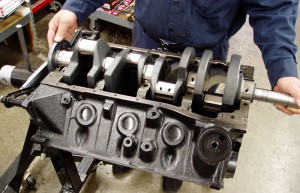
Finally, if a crank won’t spin freely in the block when the main caps have been tightened down, recheck the clearances because one or more bearings are too tight, or there is a misalignment problem in the main bores, or the crank is bent.
Bearing Loads And Friction
Years ago, NASCAR engine builders discovered that if they ran crankshafts with smaller diameter journals, they could pickup some extra horsepower. Reducing the circumference of the bearings reduced friction. A crankshaft with smaller journals was also lighter and revved faster. But there were a couple of tradeoffs. The smaller journals also reduced the strength of the crank, so there was a limit as to how far they could go without dangerously weakening the crank. Also, reducing the diameter of the journals increased the loading on the bearings.
The larger the bearing, the broader the area over which the load is distributed. The smaller the bearing, the more concentrated the load is over a given portion of the bearing. Tightening up the bearing clearances and using lower viscosity oil helps distribute the load over a broader area of the bearing.
Regardless what type of bearings are used in an engine, clearances have to be precise and correct for the oil viscosity that will be used to lubricate the motor. Thin, low viscosity motor oils require tighter bearing clearances than heavier viscosity racing oils such as 20W-50 or straight 40, 50 or 60 weight oils.
Here are some recommended rod bearing oil clearances for various oil viscosities:
.0015 to .0018 for 5W-20 or 20W
.002 to .0024 for 5W-30 or 30W
.0025 to .0029 for 10W-40 or 40W
.0030 to .004 for 20W-50 or 50W
.0041 to .005 for 10W-60 or 60W
For main bearings:
.0015 to .002 for 5W-20 or 20W
.002 to .0025 for 5W-30 or 30W
.0026 to .003 for 10W-40 or 40W
.0031 to .0041 for 20W-50 or 50W
.0042 to .0052 for 10W-60 or 60W
 Tighter bearing clearances reduce noise and vibration in an engine, but also require more precise and accurate machining. If you can’t achieve good main bore geometry (less than .002˝), you shouldn’t try to run tight clearances.
Tighter bearing clearances reduce noise and vibration in an engine, but also require more precise and accurate machining. If you can’t achieve good main bore geometry (less than .002˝), you shouldn’t try to run tight clearances.
Also, if you’re building an engine with aluminum rods, the rods will undergo more thermal expansion when they get hot than steel rods, so you have to compensate for that when setting up your bearing clearances.
The type of racing will also affect rod and main bore distortion as well. Drag racing and truck/tractor pulling can create more bore distortion than other types of racing, so again you may have to compensate when setting up the bearing clearances.
The best way to check bearing clearances is with a dial bore gauge and micrometer rather than a plastic strip. Measure the diameter of the crank journals, then measure the inside diameter of the rod bearings when they are assembled in the rods, and the main bearings when they are assembled in the main bores. Write all the numbers down, then subtract to determine the bearing clearances.
Bearings should never be installed dry. Lubricate with engine oil or assembly lube, make sure all oil holes are properly aligned and that there are no dirty fingerprints or contaminants on or behind the bearings.
Finally, if a crank won’t spin freely in the block when the main caps have been tightened down, recheck the clearances because one or more bearings are too tight, or there is a misalignment problem in the main bores, or the crank is bent.
don,t forget that oil flow rates, and reducing the transmission fluid temp in the lower radiator on cars equipped with an automatic transmission, have a big effect on engine cooling so adding a trans or oil cooler helps engine durability
Loves302Chevy posted these diagrams that will be helpful
READ THROUGH THIS LINKED THREAD
http://garage.grumpysperformance.com/index.php?threads/precision-measuring-tools.1390/#post-52469
https://www.hotrod.com/articles/ccrp-0911-small-block-chevy-oil-pumps/


http://garage.grumpysperformance.com/index.php?threads/magnets.120/#post-49772
Engine Bearings Under Pressure
by Larry Carley - Dec 4, 2015

You need to know what you’re talking about when you’re looking at engine bearings. Illustration courtesy of MAHLE Aftermarket.
Engine bearings have to withstand punishing loads in today’s engines. Smaller displacements, turbocharging and higher horsepower ratings mean crankshaft and connecting rod bearings are being subjected to heavier loads. This has led to the development of some new bearing alloys and coatings that enable these parts to survive.
It’s the same story with high performance. Today’s hi-flow, aftermarket, CNC-ported cylinder heads, high lift killer cams and induction system power adders (blowers, turbos and nitrous) are making more power than ever before, and really hammering the bottom end of the engine. If the bearings can’t take it, the engine won’t last.
The stock production aluminum bearings that are used in many late model engines can usually handle up to 500 horsepower before they get into trouble, and over 300 horsepower in a turbocharged four-cylinder engine. But once you get beyond these power levels, bearing fatigue can be a problem. At that point, you have to upgrade to a stronger material of some type, be it a tougher aluminum alloy or a performance tri-metal bearing.
The rod bearings take the most punishment because of the reciprocating motion of the pistons and rods. The load on the rod bearings change with the crank angle and RPM, and whether the cylinder is on its power stroke, compression stroke, intake stroke or exhaust stroke. The upper rod bearings bear the heaviest loads during the power stroke when combustion pressure is ramming the piston and rod down hard against the crank. But the upper rod bearings can also see heavy loads in boosted engines during the compression stroke, and on the exhaust stroke, too – especially in engines that are burning nitrous or nitro. The lower rod bearing can also experience extreme G-forces and loading in a high-revving engine during the exhaust stroke. That’s when most connecting rod and rod bearing failures occur.
The bearings in a stock engine typically had to withstand loads of up to 6,000 PSI or higher depending on the engine’s power output per cubic inch. In a performance engine or a high compression diesel, peak loads can range from 8,500 up to 10,000 PSI or higher.
Bearing manufacturers offer a range of materials with various strength and fatigue resistance ratings to handle every kind of engine application, stock or performance. Some of the better aluminum bimetal alloys (aluminum overlay on a steel shell) can safely handle peak loads of up to 8,000 PSI or higher, while many “race series” tri-metal bearings are good for 10,000 PSI or more. Some specialty bearing materials such as those that have been developed for big, heavy-duty, high output, turbo diesel engines are rated as high as 20,000 PSI. Some of the more exotic bearing materials are applied to the bearing shell using “sputter” or a “PVD” (physical vapor deposition) process in a vacuum-controlled environment. This allows the material to be built up to the desired thickness with a high degree of accuracy.

This illustration shows how the oil forms a wedge to lift and lubricate the bearing. The oil film also helps spread the load on the bearing and cushion it against the constant pounding (courtesy of King Bearings).
Alloys And Attitudes
The ideal bearing provides a good combination of durability, fatigue resistance and embedability. Durability means the bearing is strong enough to withstand the peak loads it experiences inside the engine. Fatigue resistance means the bearing won’t crack or flake after millions of engine revolutions and combustion cycles. Embedability means any dirt or wear particles that find their way into the oil film between the bearing surface and crank journal will be pressed into the bearing surface rather than scoring the crank journal.
Engineers today have software that can simulate the loading on a bearing based on an engine’s displacement, bore and stroke, horsepower output, compression ratio and RPM. They can predict how well a given bearing material will hold up in a particular application. So using their software and real world experience, they can recommend a specific type of bearing based on what your requirements are. Are you building a stock motor? A street/strip dual-purpose engine? A petal-to-the-metal drag motor, or truck or tractor puller engine? A circle track or endurance motor? A marine inboard motor?
For most racing applications, you want a bearing that is both durable and fatigue resistant. Drag racing can be really hard on bearings because a relatively cold engine suddenly goes from idle to full throttle for maybe 4 to 12 seconds until the car reaches the end of the strip. The short burst, extreme loading of the bearings means the bearings have to be the right material to withstand the hammering. That’s why tri-metal bearings have traditionally been used in drag motors. But high strength aluminum bearings can also take this kind of short-term abuse, too, according to the manufacturers who make them. In fact, one crankshaft supplier we talked to for another article indicated that aluminum race bearings hold up better in a blown motor than tri-metal bearings.
With a dirt track motor, the engine is going to run a series of laps, alternating between wide open throttle and throttle off. The bearings experience peak loading for a longer period of time when the driver floors the throttle out of the turns. And a feature event usually goes at least 25 or more laps, so durability and fatigue resistance are critical. Tri-metal bearings have traditionally been the bearing of choice for this type of racing. But aluminum performance bearings are also being used in some of these engines.
In a marine application, fatigue resistance is even more important because the engine usually runs flat out for long periods of time. Tri-metal is probably the most common choice here, too.

Construction of various bearing types (courtesy of King Bearing)
Bearing Construction
Tri-metal bearings are made of a copper-lead-tin alloy applied to a steel shell with a thin lead babbit overlay. The babbit overlay provides good seizure resistance. Reducing the thickness of the babbit overlay to .0005 inches is one of the tricks bearing engineers can use to increase fatigue resistance in a performance bearing. A thinner overlay still provides a good bearing surface, but much less embedability. Some tri-metal bearings may also have a hardened surface layer, which improves the load carrying capacity of the bearing.
Aluminum alloy bimetal bearings have been the bearing material of choice for stock production engines because they are long-lived. Aluminum bearings typically have an aluminum-tin-silicon alloy overlay about .012 inches thick on a steel shell. Aluminum alloys can be both strong and soft, providing good strength and embedability. Tin (which may be 6 to 20 percent of the alloy) reduces friction and acts as a solid lubricant. Hard particles of silicon (maybe 2 to 4 percent) may also be added to improve strength and wear resistance. Silicon is essential for engines with cast iron crankshafts to reduce the risk of seizure if the oil film is disrupted. Small amounts of copper, nickel and other elements may also be added to the aluminum alloy to further enhance the properties of the bearing material.
Lubrication Issues
Bearing lubrication is critical from the instant the engine turns over until it is shut down. If a rod or main bearing is starved for oil causing the oil film between the bearing surface and crank journal surface to go away, galling, seizure and failure can occur in an instant.
The babbit top layer on a tri-metal bearing serves as a sacrificial layer when this happens. It can prevent seizure until the babbit wears away. At that point, the situation goes south very rapidly. The bearing usually seizes, locking up the motor or breaking the connecting rod.
With aluminum bimetal bearings, the situation is somewhat different according to tests conducted by one bearing manufacturer. If the oil film between the bearing and crank goes away, there is actually less risk of seizure and failure with their performance bimetal aluminum racing bearing.

Polyamide coated Irox bearings not only provide added wear protection in Stop/Start engine applications, but also improved fatigue resistance (courtesy of Federal-Mogul).
Coated Bearings
One way engine builders have tried to reduce the danger of engine damage if an engine loses oil pressure during a race is to use coated bearings when they put the engine together. Aftermarket coating suppliers have offered various proprietary coating materials for bearings, pistons and other parts for many years. Only recently have coated bearings become mainstream and readily available from major bearing suppliers. Some bearing suppliers coat their own bearings while others still use an outside vendor to apply the coatings.
Bearing coatings can provide several benefits. They can prevent dry-starts to extend bearing life, as well as provide some degree of protection and seizure resistance if the engine loses oil pressure in a race. Some coatings also have oil retaining properties that help maintain an oil film between the bearing and crank journal. A coating also improves conformability to the crankshaft journal, as well as embedability.
A dry film polymer-based coating will sacrifice itself if the engine loses oil pressure – which can often make the difference between a ruined crankshaft and blown motor or a motor that can be easily rebuilt and raced again with a new set of bearings.
Some bearing coatings contain PTFE (Teflon) because of its anti-friction characteristics. The polymer resin may also contain other ingredients such as graphite, molybdenum disulfide for added lubricity, and/or microscopic iron particles to improve wear resistance and durability. One manufacturer who applies a special iron-based dry film coating to its engine bearings claims its coating reduces wear 500 percent over an uncoated bearing, and improves fatigue resistance 20 percent.
Coating bearings are even being used in some late model production engines. Some OEMs are now using polyamide coated bearings in engines with idle Stop/Start systems as well as some light truck diesel engines. One bearing supplier reported that it will introduce a new aftermarket coated bearing for the Ford 6.7L Powerstroke diesel in early 2016. Other applications will likely follow.
As for the Start/Stop applications, shutting the engine off when a vehicle stops moving and remains motionless for more than a few seconds improves the vehicle’s overall fuel economy, especially in city stop-and-go driving. But it also means the bearings in these engines experience more cranking cycles and an increased risk of metal-to-metal contact between the bearings and crank. Lubrication is minimal until the rotation of the crankshaft forms a hydrodynamic oil wedge between the bearings and crank journals. Uncoated bearings typically show severe wear after 100,000 start cycles, whereas coated bearings that are designed for 250,000 to 300,000 starts show almost no measurable wear.
The new polyamide coating that is being used in these applications has an added benefit: it also improves the durability of aluminum bearings to that of many tri-metal bearings. The amide-coated bearings can handle peak loads that are up to 25 percent higher than uncoated aluminum bearings made with the same alloy. The amide coating also cuts the coefficient of friction in half compared to a bare aluminum uncoated bearing.
The new high tech bearing coatings are unaffected by the type of fuel used (standard gasoline or E85) or the type of oil (conventional or synthetic). The coating also allows the use of lower viscosity motor oils for added friction reduction and fuel savings.

Finally, if a crank won’t spin freely in the block when the main caps have been tightened down, recheck the clearances because one or more bearings are too tight, or there is a misalignment problem in the main bores, or the crank is bent.
Bearing Loads And Friction
Years ago, NASCAR engine builders discovered that if they ran crankshafts with smaller diameter journals, they could pickup some extra horsepower. Reducing the circumference of the bearings reduced friction. A crankshaft with smaller journals was also lighter and revved faster. But there were a couple of tradeoffs. The smaller journals also reduced the strength of the crank, so there was a limit as to how far they could go without dangerously weakening the crank. Also, reducing the diameter of the journals increased the loading on the bearings.
The larger the bearing, the broader the area over which the load is distributed. The smaller the bearing, the more concentrated the load is over a given portion of the bearing. Tightening up the bearing clearances and using lower viscosity oil helps distribute the load over a broader area of the bearing.
Regardless what type of bearings are used in an engine, clearances have to be precise and correct for the oil viscosity that will be used to lubricate the motor. Thin, low viscosity motor oils require tighter bearing clearances than heavier viscosity racing oils such as 20W-50 or straight 40, 50 or 60 weight oils.
Here are some recommended rod bearing oil clearances for various oil viscosities:
.0015 to .0018 for 5W-20 or 20W
.002 to .0024 for 5W-30 or 30W
.0025 to .0029 for 10W-40 or 40W
.0030 to .004 for 20W-50 or 50W
.0041 to .005 for 10W-60 or 60W
For main bearings:
.0015 to .002 for 5W-20 or 20W
.002 to .0025 for 5W-30 or 30W
.0026 to .003 for 10W-40 or 40W
.0031 to .0041 for 20W-50 or 50W
.0042 to .0052 for 10W-60 or 60W
 Tighter bearing clearances reduce noise and vibration in an engine, but also require more precise and accurate machining. If you can’t achieve good main bore geometry (less than .002˝), you shouldn’t try to run tight clearances.
Tighter bearing clearances reduce noise and vibration in an engine, but also require more precise and accurate machining. If you can’t achieve good main bore geometry (less than .002˝), you shouldn’t try to run tight clearances.Also, if you’re building an engine with aluminum rods, the rods will undergo more thermal expansion when they get hot than steel rods, so you have to compensate for that when setting up your bearing clearances.
The type of racing will also affect rod and main bore distortion as well. Drag racing and truck/tractor pulling can create more bore distortion than other types of racing, so again you may have to compensate when setting up the bearing clearances.
The best way to check bearing clearances is with a dial bore gauge and micrometer rather than a plastic strip. Measure the diameter of the crank journals, then measure the inside diameter of the rod bearings when they are assembled in the rods, and the main bearings when they are assembled in the main bores. Write all the numbers down, then subtract to determine the bearing clearances.
Bearings should never be installed dry. Lubricate with engine oil or assembly lube, make sure all oil holes are properly aligned and that there are no dirty fingerprints or contaminants on or behind the bearings.
Finally, if a crank won’t spin freely in the block when the main caps have been tightened down, recheck the clearances because one or more bearings are too tight, or there is a misalignment problem in the main bores, or the crank is bent.
Last edited:

http://www.harborfreight.com/36-piece-3 ... 60669.html
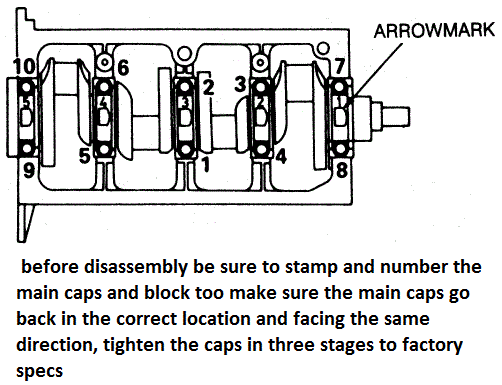

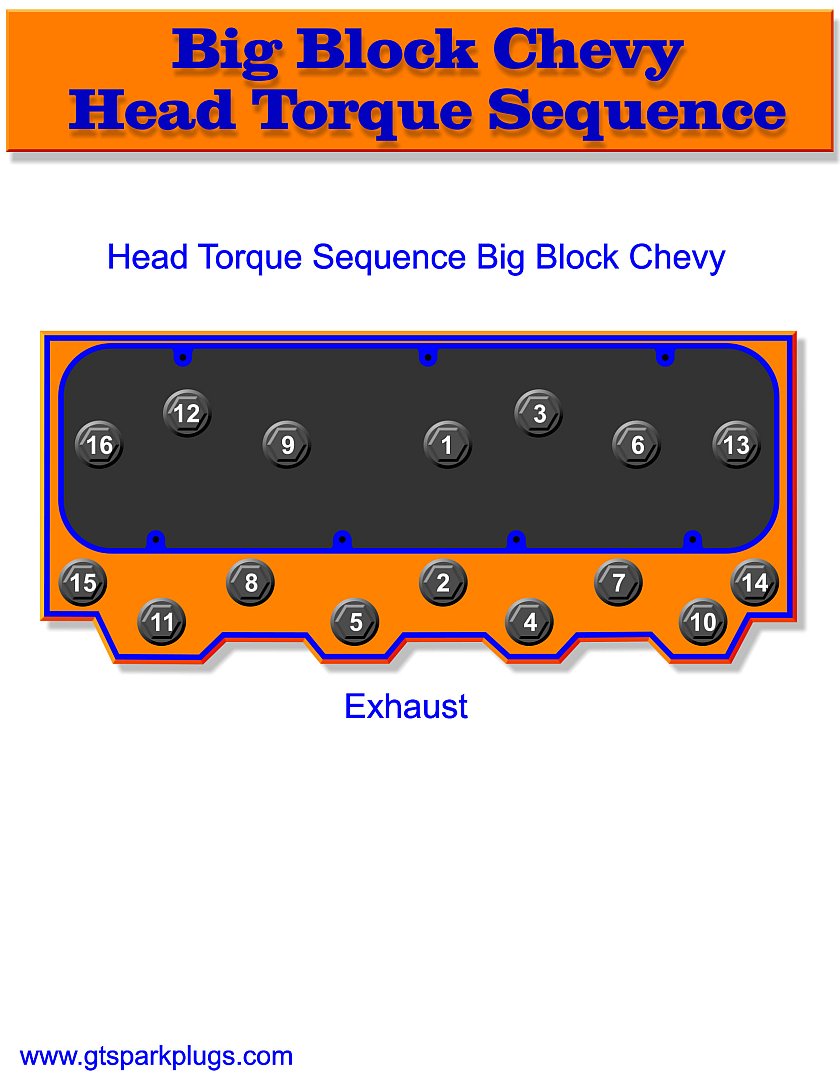
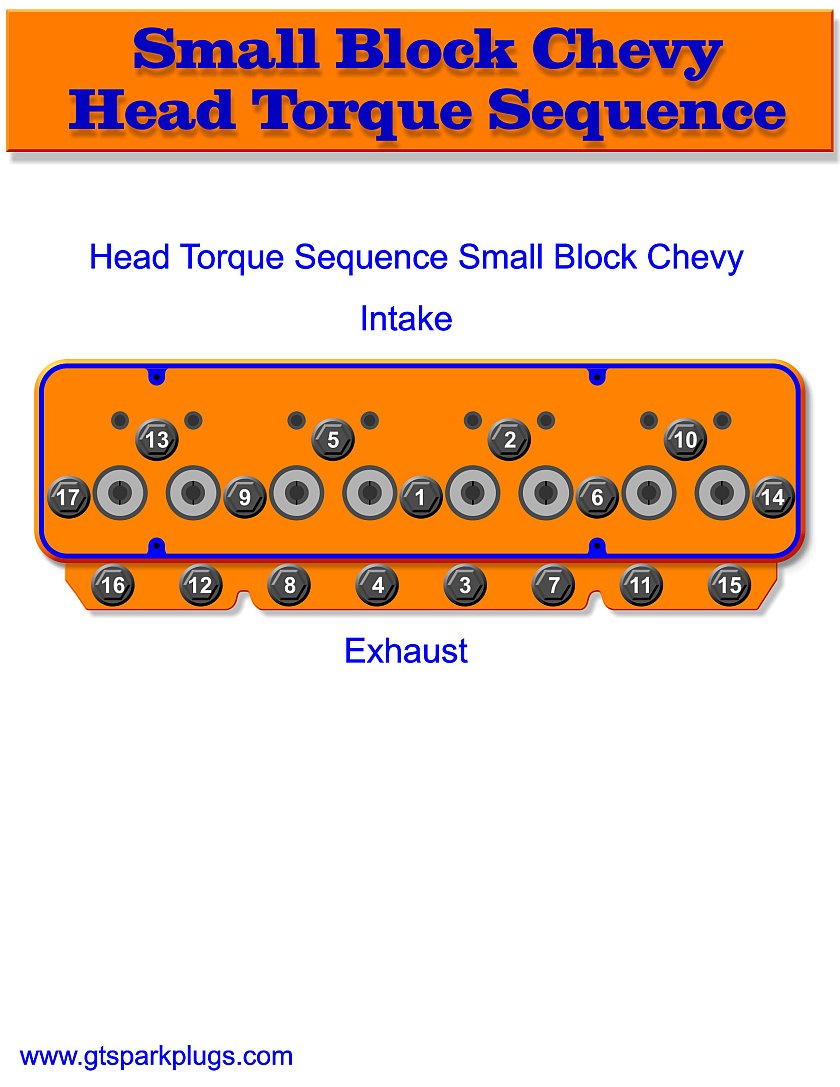
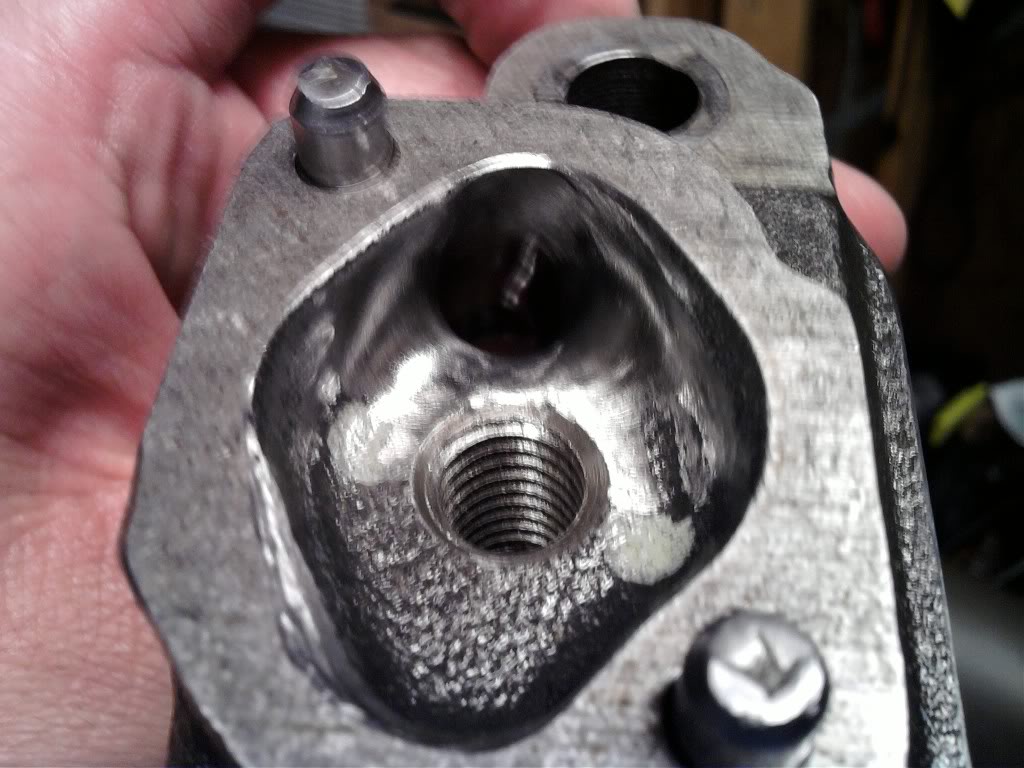
notice the open slot between the rear main cap supporting the oil pump and bearing shell support and the area supporting the rear main seal, this prevents PRESSURIZED oil from the bearings reaching the rear main seal.
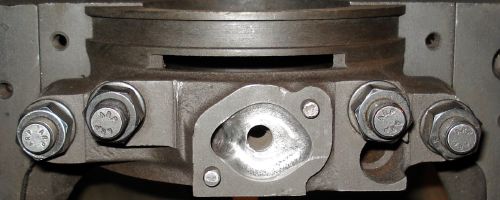
the as cast recess in the rear main cap where the oil pump mounts can be rather restrictive and shallow, and if your replacing a missing main cap , with one from a different block you'll very likely be required to have the block?cap too be line honed to get the correct alignment and fit clearances for the crank shaft
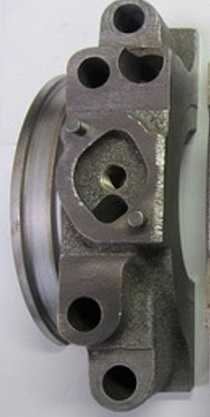
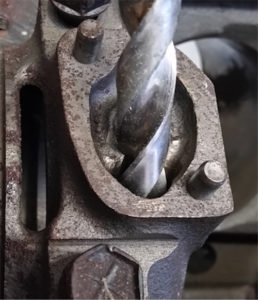
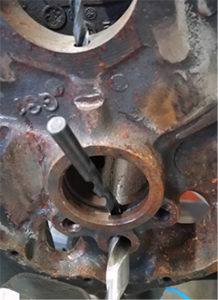
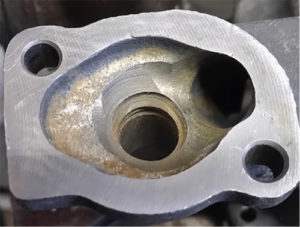

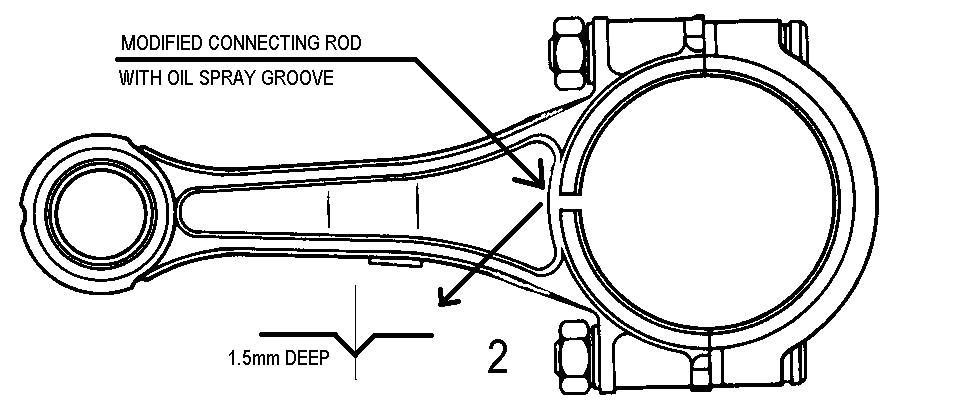


Oiling Systems for Grassroots Racing
by Larry Carley - Dec 4, 2015
0 2100
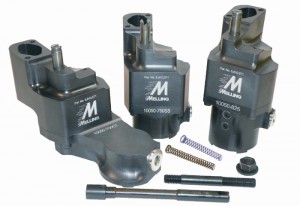
Billet pumps offer the utmost in strength and precision for wet sump oiling systems, however some rules may limit their use to specific classes (courtesy Melling).
Grassroots racing is the backbone of the performance industry in this country. It’s weekend racing at small town local tracks, drag strips and road courses by average Joes’ who just enjoy racing. They race for glory and peanuts prize money. They don’t have mega-million dollar sponsorships, high paid crew chiefs or engineers, or a PR agent to deal with their fans. They’re not celebrities, household names (except maybe at their own track) or into product endorsements. These are the racers who make up the majority of our reader’s customer base.
In researching this article, we discovered that there are more than 1,200 dirt tracks around the country (most of which are 1/4 mile, 3/8 mile or 1/2 mile tracks), about 120 drag strips (1/8 and 1/4 mile), and a few dozen paved road race courses (excluding off-road courses). Many of the dirt tracks also serve double-duty for truck and tractor pulling events, too.
Rules, Rules, Rules
Rules dictate what is and what isn’t allowed in all types of racing, whether grassroots or professional. Rules are established for a reason. The main purpose (besides safety) is to equalize competition so the rich guys with deep pockets can’t outspend competitors and have an unfair advantage over the other racers in the class.
A dry sump oiling system that’s capable of pulling a strong vacuum in the crankcase can provide a 10 to 15 horsepower advantage over a wet sump system that has a lot of windage and drag in the crankcase. So if the rules only allow wet sump systems, everybody is on the same page more or less as far as crankshaft windage and drag are concerned.
On the other hand, even if the rules restrict everybody to using a wet sump system, there’s a lot of wiggle room as to what type of wet sump system a racer may use. A wet sump system with a well designed scraper in the oil pan can cut crankshaft windage significantly. Building the engine with tighter rod and main bearing clearances and using a lighter viscosity synthetic racing oil also means you can get away with less oil pressure, which means less power consumed to drive the oil pump and more power at the crankshaft. And for endurance racing, adding an external oil cooler and/or oil reservoir can keep oil temperatures within safe limits – which reduces the risk of blowing an engine and not finishing the race at all.
A secondary reason for rules is to limit costs so the “little guys” can afford to compete and to equalize competition. Keeping costs down is a cornerstone of grassroots racing. The sky is the limit as to what a racer can spend on modifications and goodies for his racecar. By putting a lid on what they can modify or what parts are allowed, rules keep racing affordable and competitive (in theory, anyway). Creative individuals can always find ways around the rules by stretching what the rules say (or don’t say), while others simply ignore the rules and find ways to cheat – until they get caught.
So priority one when choosing an oiling system for any type of racing (grassroots or professional) is to establish what the rules allow and prohibit. Somebody has to read the rule book. Whether that’s you or your customer it doesn’t matter. The oiling system has to fit within the framework of the rule book. Period.
To keep costs down, most dirt tracks prohibit dry sump systems in most stock, sportsman, late model and modified classes. A track may have its own rules or may subscribe to the rules of a particular sanctioning body such as the American Motor Racing Association (AMRA), DIRTcar, International Motor Contest Assn. (IMCA), United Midwestern Promoters (UMP), U.S. Auto Club (USAC) or another group or sponsoring organization. With drag racing, most strips follow National Hot Rod Association (NHRA) or International Hot Rod Association (IHRA) rules. For road courses, the sanctioning body may be the Sports Car Club of America (SCCA), National Auto Sport Association (NASA), World Racing League (WRL) or a local car club’s own rules.
As far as lubrication systems go, some rules are rather broad and generalized. Rules that prohibit dry sump systems may allow any type of wet sump system. Other rules may limit wet sump systems to “pure stock” components or “stock appearing” aftermarket parts (which leave some wiggle room for a higher flow oil pump and/or stronger castings).
Some oiling system rules are extremely specific. These rules only allow certain OEM part numbers to be used (with no or limited internal modifications to oil pumps and pans). Or, these rules may allow only certain aftermarket parts to be used. SCCA rules are VERY specific about this in many classes, listing specific brands and part numbers of aftermarket parts that are allowed. The SCCA rule book is a hefty 942 pages – more than double the 324 pages in the NHRA drag racing rule book.
In situations where the rules are very restrictive, your hands may be tied as to what sort of changes or modifications you can do on a customer’s engine. The rules may prohibit any porting or blending of the ports in an oil pump, or using a higher output pump. But even in stock classes that only allow OEM or “OEM equivalent” unmodified oil pumps, most rules allow for a certain amount of “blueprinting” of the pump housing and internal components. This would include things like minimizing clearances between the end of the gears and the housing, select fitting gears to reduce pumping losses, deburring and cleaning up oil inlet and outlet ports (without enlarging the ports or changing the basic configuration), changing the oil bypass valve and spring, brazing the oil pickup tube to the pump housing so it doesn’t work loose during a race, etc.
It’s essential that you and your customer are on the same page as far as the rules are concerned, and that you know what your boundaries are as to what you can modify and improve BEFORE you make any changes. After all, you don’t want to make changes that may end up disqualifying a racer if the engine is torn down for a technical inspection.
If the rules allow a modified pump to be installed, go for it. Some performance pumps include larger inlet and out ports, anti-cavitation slots in the housing and cover to minimize oil aeration and pressure losses at high RPMs, adjustable oil bypass valves and improved valve designs for better pressure control, special bypass ports that reduce pumping effort and improve pump priming, stronger castings with larger gears, or billet steel and aluminum pumps for applications that require maximum strength.
On late model engines with front mounted pumps (Chevy LS, Ford modular, etc.), the factory pump covers are often stamped steel and rather flimsy. These pumps often leak a lot of oil at high RPM, resulting in erratic oil pressure readings. Installing a high quality aftermarket pump with a cast iron or heavier steel cover plate can help maintain consistent oil pressure.
High flow oil pumps may be needed for certain applications, such as engines that use piston or valve spring oilers, or that have Variable Valve Timing (VVT). But these pumps shouldn’t be used as a Band-Aid to maintain oil pressure in an engine that is worn or has sloppy bearing clearances. The last thing you want to put into a high performance engine is a cheap oil pump!

Aftermarket performance oil pumps feature various modifications to improve flow and priming. The performance pump in this photo has a much larger inlet port, and a special add-on port to help self-prime the pump (courtesy of Schumann).
Some Specific Recommendations
To find out what type of oiling systems are recommended for grassroots racing, we contacted various aftermarket suppliers for their advice. What follows is a condensed version of what they had to say.
Within the framework of the rules that apply for a particular type of racing, there are several things that have to be considered. One is what you are trying to accomplish? Are you trying to prevent oil pressure loss, are you trying to control engine oil temperature, or are you trying to accomplish both? What kind of demands are being placed on the engine and oiling system?
If you don’t know what parts are best for a given application, talk to the parts supplier for their input. They design their products for specific kinds of applications and can guide you as to which oil pan, pump or oiling system setup will work best in a given application.
Drag racing has very different oiling demands and conditions than circle track or road racing. Drag motors are fired up cold, make a short full throttle blast down the strip and are then shut down or are driven slowly back to the pits for the next round of racing. The oil never gets very hot, and all the G-forces inside the pan are fore and aft (no side forces). With circle track motors, the engine may run a 10 lap heat, a 25 lap semi-final or main event, or an even longer race. The oil gets hot and sloshes fore and aft and towards the outside right side of the oil pan. Road racing is similar except that the races are usually longer and the cars turn both right and left, which requires different oil pan arrangement.
There are several key design features to a properly baffled oil pan. The first is pickup location. Depending on the type of racing, the pickup location and baffling is critical. Drag racers typically run deeper (taller) oil pans. However, the best pickup location for drag racing is actually in the middle of the sump with trap doors front and back. This arrangement keeps the oil where it belongs when launching off the line and during braking and shutdown at the end of the strip. More oiling issues typically occur at the end of the strip than at the starting line in drag racing because some oil pans allow the oil to slosh forward away from the pickup when negative G-forces occur with braking.
With dirt track racing, the pickup should be located in the right side rear of the pan because the car is always turning left turns. The pan also needs a scraper to help direct oil away from the crankcase for reduced windage and drag. The pan also needs a kickout on the right side to keep the oil in the vicinity of the pickup. A kickout also adds additional oil capacity to reduce the risk of oil aeration, oil starvation and overheating.
In road racing with a wet sump oiling system, a diamond style trap door baffle located in the center of the sump helps control oil sloshing during acceleration, deceleration and cornering. Side kickouts in the pan can provide additional oil capacity as well as lower the overall height of the oil pan so the engine can be mounted lower in the chassis to reduce the center of gravity and overall ride height.
In high capacity oil pans, baffling and a windage tray are essential to keep oil away from the crank. If you just bolt on a higher capacity pan that contains nothing to prevent the oil from sloshing around, it can get whipped into foam by the crankshaft creating drag as well as oil aeration and loss of oil pressure. That’s the last think you want happening in a racecar.
Another upgrade that should be considered when the rules allow it is some type of reserve oil pressure accumulator. An accumulator can provide added insurance against loss of oil pressure when extreme G-forces are encountered (fore, aft, sideways or vertically in the case of off-road vehicles). Guys who are running sticky race compound tires on a road course can really benefit from an accumulator. Just ask the guy who didn’t have an accumulator and blew his engine because he lost oil pressure in the long hard turn.
An accumulator consists of a cylinder with a piston inside. The backside of the piston is pre-charged with nitrogen to serve as an air spring. The front side of the piston is plumbed into the engine’s oiling system. As the oil pump builds pressure it pushes oil into the accumulator, pushes the piston backwards and compresses the air charge behind the piston. This creates a reserve supply of oil pressure that discharges back into the engine when oil pressure drops below a certain pressure. The accumulator can also be used to prime the oil system prior to starting it by opening a manual valve. This reduces the risk of a dry start and metal-to-metal contact.
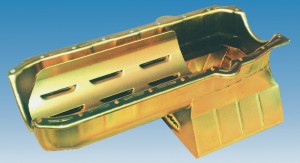
Drag race oil pans typically have a deeper sump and extra capacity. But they aleo require good internal baffling to keep the oil where it belongs at both ends of the track (courtesy of Milodon).
Dry Sump Setups
Hot oil, especially low viscosity synthetic oil, gets as thin as water and sloshes around quite a bit inside an oil pan during an endurance race or road race. It may be more than a well-designed wet sump system can handle. So it may be necessary to upgrade to a dry sump system if the rules allow it.
Dry sump systems are the ultimate setup because they eliminate all of the problems that can occur with oil sloshing around inside the crankcase. By sucking all of the oil out of the pan, routing it into a storage canister, allowing the air to separate from the oil, the pump (which is usually externally mounted and belt driven off the crankcase) can provide a steady supply of oil to the engine under even the most extreme G-forces.
The most basic dry sump systems typically include an external three-stage pump (a pressure pump to supply oil pressure to the engine, and two suction pumps to pull oil out of the engine), a shallow custom oil pan with scavenge ports for the suction pumps, and an external oil reservoir. The higher end systems contain multiple stage suction pumps to pull vacuum inside the crankcase for reduced windage and drag. A larger oil reservoir and/or external oil cooler helps keep the oil temperatures within safe limits.
The location and capacity of an oil reservoir tank may be regulated by rules. Most rules allow the tank to be mounted inside the vehicle behind the driver, with oil lines extending through the firewall to connect the tank to the pump and engine. On off-road and road racing applications, a tall skinny tank is better than a short, wide tank because it helps keep the oil from climbing up the sides of the tank (good internal baffling is also important). Some off-road racers even mount the tank on gimbals so it will remain vertical regardless of the attitude of the vehicle itself.
The only real drawback of dry sump oiling systems is the cost, which can range from around $2,500 for a basic system up to $5,000 or more for a multi-stage high end custom setup. Although a dry sump system costs a lot more than a typical aftermarket high output oil pump and modified oil pan, the problems it eliminates and the protection it provides can more than pay for itself.
One dry sump oiling system supplier we interviewed said dry sump systems should be allowed in dirt track racing because it actually saves money in the long run by protecting a racer’s engine. Blowing an engine because a wet sump system failed to maintain good oil pressure in a race costs a lot more than adding on a dry sump oiling system.
Some say its time to change the rules so racers can have the option of running a dry sump system instead of a wet sump system. The competitive advantage of a dry sump system could be limited by restricting the system to a basic three-stage spur gear pump with a maximum length of 7 inches so the system can’t pull vacuum in the crankcase. Open venting of the crankcase and/or valve covers would also be required to prevent the system from pulling vacuum. These simple rule changes could open the door for dry sump systems in dirt track racing while reducing engine failures due to loss of oil pressure. Costs could be minimized by using relatively inexpensive reservoirs and modifying existing oil pans (welding on a couple of suction ports). If you agree, talk to your local racetrack sanctioning body about updating the rules to allow dry sump oiling systems in grassroots racing.
What about street performance, street/strip applications? For most stock and performance street applications, a wet sump oil system works fine. A dry sump system would be overkill and an unnecessary expense. The stock oiling system can be upgraded with a good aftermarket performance pump. You don’t necessarily need a higher flow pump unless you are building the engine “loose” and need more flow to maintain good hot idle oil pressure. The old rule of 10 PSI of oil pressure from every 1,000 RPM is still a good one for most street and street/strip motors. Excessive oil pressure just wastes energy and horsepower, and ends up dumping oil back into the crankcase.
Last edited:
8
87vette81big
Guest
My link still works off my phone.
My article different yet.
My article different yet.
Loves302Chevy
"One test is worth a thousand expert opinions."
This is what I get by clicking your link:
We're sorry - that page must have moved.
Please use our search feature, navigation or select articles below.
Did not work for Grumpy either.
I don't have a cell phone (I'm that ONE), but if you saved the article as a page or file
in your phone, that's why it still works for you.
We're sorry - that page must have moved.
Please use our search feature, navigation or select articles below.
Did not work for Grumpy either.
I don't have a cell phone (I'm that ONE), but if you saved the article as a page or file
in your phone, that's why it still works for you.
8
87vette81big
Guest
8
87vette81big
Guest
by Larry Carley - Mar 26, 2013
Is it better to build an engine with tighter bearing clearances and run it on low viscosity synthetic motor oil, or is it better to build an engine with more traditional or even looser bearing clearances and use heavier viscosity oil?
Tight bearing clearances and relatively thin synthetic multi-viscosity motor oils work well in many performance applications from NASCAR and circle track racing to drag racing.
Keep in mind, however, that most of these engines are purpose-built engines that are machined with exacting tolerances. Crankshaft journals are precision ground to be as round, flat and true as possible, the journals are micropolished to a mirror-like finish of a couple microinches Ra or less, the bearings are precision fit to exact tolerances using a bore gauge and micrometer (not deformable plastic gauge), and the engines are run on high quality synthetic racing oil, not ordinary motor oil.
The oil clearance is the gap between the inside diameter of an installed bearing and the outside diameter of the crankshaft or camshaft journal. The clearance is measured 90 degrees to the bearing parting line, which is the thickest part of the bearing (bearing thickness tapers slightly toward the parting line).
Reducing the oil clearance between the rod and main bearings and the crankshaft has a number of advantages. A smaller gap spreads the load over a wider area of the bearing surface and distributes pressure more uniformly across the bearing. That’s good, provided the bearing is strong enough to handle it. A smaller gap also decreases the volume of oil that has to flow into the bearing to maintain the oil film between the bearing and shaft.
That’s also good, provided the oil is thin enough (low viscosity) to flow well into the bearing. This also reduces the amount of oil pressure the engine needs, so some extra horsepower is gained by reducing the load on the oil pump.
In a NASCAR engine, rules limit the minimum diameters of the rod and main journals on the crankshaft. The rods are 1.850? in diameter while the mains are 1.999?. Most of these engines are running rod and main bearing clearances of .001? or less, and they are doing it with low viscosity racing oils such as 0W5, 0W30 and 0W50. These racing oils are as thin as water and are highly friction modified.
They also contain extra anti-wear additives such as ZDDP (phosphorus levels up to 1,850 ppm or higher) to protect the cam lobes and flat tappet lifters. These are race-only oils and are not recommended for street use because they do not contain the same detergents, dispersants and corrosion inhibitors as ordinary motor oils. Ordinary motors have to handle extended oil drain intervals while racing oils do not. Also, the level of ZDDP is too high for late model vehicles equipped with catalytic converters.
With fuel injection, many NASCAR engines are now making close to 900 horsepower without a restrictor plate, and are turning 9,500 rpms for 500 miles. The bearings take quite a pounding but hold up extremely well (when was the last time you heard of a NASCAR engine blowing because of a bearing failure?). But what works great for NASCAR may not work in other forms or racing or on the street.
One of the disadvantages of closer bearing clearances is that it can increase both bearing and oil temperatures. That’s no problem as long as the bearings and oil can handle the heat, but if they can’t it increases the risk of lubrication breakdown and bearing failure. That’s why high quality synthetic motor oil is absolutely essential if you are building an engine with tighter than normal clearances.
The old rule of thumb is to provide .0007? to .001? of bearing clearance for every inch of shaft diameter in a stock engine. Consequently, if the crankshaft has two-inch diameter journals, the rod and main bearings should be assembled with about .0015? to .002? of clearance.
For performance applications, some bearing manufacturers recommend adding an extra half a thousandth of clearance. Why? Because the rod bores don’t stay round in a performance engine at high rpm. When the piston reaches top dead center on the exhaust stroke, inertia stretches the rod and elongates the bore on the big end of the rod. This, in turn, deforms the bearings and reduces bearing clearances on the lower rod bearing while increasing it on the upper rod bearing.
For high revving performance engines, some bearing manufacturers recommend rod bearing clearances of .002? to .003?, with an absolute minimum clearance of no less than .0015?. The tighter the clearances, the tighter the geometry requirements are for the crank journals (as round, straight and smooth as possible with little or no taper).
Street engines can benefit from tighter tolerances and thinner oils for everyday driving. But when power adders such as nitrous oxide, turbocharging or supercharging are used, or the engine’s power output gets up in the 450 to 500 plus horsepower range, looser bearing clearances are probably safer to accommodate crankshaft flexing, main bore and rod bore distortion.
The same reasoning applies to drag motors, truck pull engines and other performance engines that produce serious horsepower. Many of these engines are built with rod and main bearing clearances in the .0025? to .003? range.
For the Saturday night dirt track racer, clearance is your friend because of the contaminants that often get into the crankcase. Looser is usually safer.
Rod and main bores should be as round as possible with no more than plus or minus .0005? of variation for a performance engine (.001? is close enough for stock). You also have to take into account the fact that the bearings themselves may not be perfect. Manufacturing tolerances of up to plus or minus .00025? are not unusual in some bearings, while others may vary only .00015? or less.
Main bore alignment is also critical. Some bearing manufacturers say adjacent main bores should have no more than .0005 inch of misalignment (.001? overall) if you are using tri-metal bearings, and no more than .002? of misalignment between adjacent bores (.002? overall) with aluminum bi-metal bearings.
One of the advantages of looser bearing clearances is that it allows more room for “slop,” which is important if the crankshaft isn’t machined to near perfection or there is some misalignment in the main bores. Wider bearing clearances do require a heavier viscosity oil (such as a 20W50 multi-viscosity oil or a straight 30, 40 or 50 oil). The heavier viscosity oil is absolutely necessary with wider clearances to maintain the oil film between the bearing and shaft so the bearing isn’t starved for lubrication. This also requires more oil pressure from the oil pump and/or more oil volume.
The amount of oil that is actually between the bearing and shaft surface at the point of highest load isn’t much. Though the installed gap between the bearing and shaft may be .001? to .0015? or more, the oil is displaced when the bearing is loaded. At its thinnest point, the oil film may only be .00002? thick (1/100th the diameter of a human hair!). That’s not much oil between the metal surfaces, but it doesn’t take much to maintain hydrostatic lubrication. When the shaft starts to turn, an oil wedge forms between the shaft and bearing that lifts the shaft up and away from the bearing surface. The shaft then glides on the oil with minimal friction.
If a crankshaft grinder wobbles while a crankshaft is being ground, it can leave lobes around the circumference of the journal. These may be invisible to the naked eye and very difficult to detect with a micrometer. But if there’s any distortion on the surface, it may interfere with the formation of the oil wedge under the shaft if the bearing clearances in the engine are too tight. Polishing the crank can reduce surface roughness on the journal but it won’t get rid of the lobes or ribbing.
Another factor to consider is that the upper Babbitt layer on a tri-metal bearing is very thin, typically .0005? to .0008? thick. The top layer of Babbitt acts as a dry film lubricant when there is no oil between the shaft and bearing. That’s fine for a dry start that may only last a couple revolutions of the crankshaft, but it is quickly wiped away if the engine starves for oil when it is running under heavy load or at high rpm.
And once the protective upper layer of Babbitt has been destroyed, the intermediate layer of copper/lead alloy will quickly seize if there’s no oil film to keep it separated from the shaft.
One of the reasons why many performance engine builders use tri-metal bearings is because they want bearings that have good seizure resistance in high rpm applications. Tri-metal bearings also handle high engine loads well and have good fatigue resistance. The Babbitt surface layer also provides embedability if dirt or debris gets past the oil filter. Tri-metal bearings are typically recommended for use with forged steel crankshafts.
Aluminum bi-metal bearings, by comparison, have high wear and corrosion resistance. With harder aluminum/silicon alloys, they can also handle higher loads while providing good anti-seize properties. Aluminum bearings are often recommended for cast iron cranks because they have a polishing effect on the journal surface. What’s more, according to some bearing manufacturers, a high silicon alloy aluminum bi-metal bearing will actually resist seizure longer than a tri-metal bearing if the protective oil film goes away.
That brings us back to the oil and bearing clearances. The oil doesn’t care what kind of bearing and shaft it is lubricating. It only needs to maintain enough oil film between the two surfaces to provide hydrodynamic lubrication and prevent metal-to-metal contact. There has to be enough oil pressure and flow to keep the bearings lubricated and cooled, and the oil itself has to have enough shear strength so it isn’t pushed out of the gap between the bearing and shaft at the point where the load is greatest.
Multi-viscosity synthetic motor oils flow more easily than conventional straight weight oils at both low and high temperatures. So they can handle cold starts as well as elevated operating temperatures (which is really important with turbochargers). To reduce friction and improve fuel economy, most late model stock engines are factory-filled with 5W20 or even 0W20 oil. Combined with tighter engine assembly tolerances, these oil and bearing combinations work relatively well for everyday driving and even mild performance use. For racing applications, though, the oil needs to be formulated specifically for racing – especially if the engine has a flat tappet cam that requires plenty of ZDDP in the additive package.
You can get oil viscosities ranging from 0W5 to 120W60, with 15W40 being a popular viscosity for stock car racing, road racing and spring cars. For wider bearing clearances, some prefer to use a heavier 15W50 or 20W50 oil. In drag racing Top Alcohol and Pro Mod classes, AHDRA Nitro Bikes and blown alcohol tractor pulling, 20W60 may be the lubricant of choice. For NHRA Top Fuel dragsters and Funny Cars, a 70WT oil might be used. So the type of oil that’s used will depend on the application and the bearing clearances inside the motor.
An additional layer of protection can be achieved by installing coated bearings. Various types of proprietary coatings are available that provide scuff resistance where there is no oil between the bearing and shaft. Such coatings cost extra, but are good insurance against dry starts and may save a crank if the engine loses oil pressure in a race.
Finally, regardless of what type of bearings you put in an engine or how close you set the bearing clearances, always use plenty of assembly lube to coat the bearings. Also, use the proper break-in oil when the engine is run for the first time. Break-in oils are typically a straight 30W oil without friction modifiers for fast ring seating. But they also contain extra ZDDP anti-wear additives to protect the cam and lifters. The break-in oil can then be drained and replaced with the type of oil (conventional or synthetic) that will be used from that point on. Be sure to tell your engine customer how important it is to use a high quality oil and that it has the correct viscosity to match the bearing clearances and lubrication requirements of the engine and application.
For more information and articles about engine bearings, visit our website and use the search feature. For information on bearing suppliers, visit our Buyers Guide.
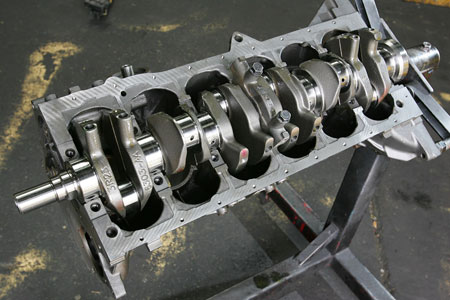
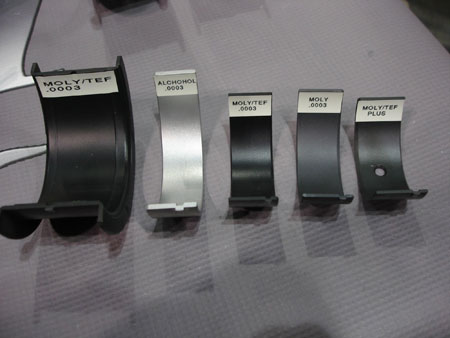

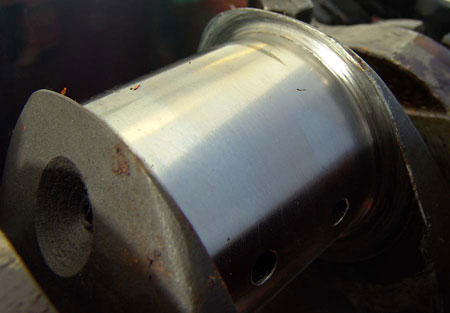

Larry Carley
Is it better to build an engine with tighter bearing clearances and run it on low viscosity synthetic motor oil, or is it better to build an engine with more traditional or even looser bearing clearances and use heavier viscosity oil?
Tight bearing clearances and relatively thin synthetic multi-viscosity motor oils work well in many performance applications from NASCAR and circle track racing to drag racing.
Keep in mind, however, that most of these engines are purpose-built engines that are machined with exacting tolerances. Crankshaft journals are precision ground to be as round, flat and true as possible, the journals are micropolished to a mirror-like finish of a couple microinches Ra or less, the bearings are precision fit to exact tolerances using a bore gauge and micrometer (not deformable plastic gauge), and the engines are run on high quality synthetic racing oil, not ordinary motor oil.
The oil clearance is the gap between the inside diameter of an installed bearing and the outside diameter of the crankshaft or camshaft journal. The clearance is measured 90 degrees to the bearing parting line, which is the thickest part of the bearing (bearing thickness tapers slightly toward the parting line).
Reducing the oil clearance between the rod and main bearings and the crankshaft has a number of advantages. A smaller gap spreads the load over a wider area of the bearing surface and distributes pressure more uniformly across the bearing. That’s good, provided the bearing is strong enough to handle it. A smaller gap also decreases the volume of oil that has to flow into the bearing to maintain the oil film between the bearing and shaft.
That’s also good, provided the oil is thin enough (low viscosity) to flow well into the bearing. This also reduces the amount of oil pressure the engine needs, so some extra horsepower is gained by reducing the load on the oil pump.
In a NASCAR engine, rules limit the minimum diameters of the rod and main journals on the crankshaft. The rods are 1.850? in diameter while the mains are 1.999?. Most of these engines are running rod and main bearing clearances of .001? or less, and they are doing it with low viscosity racing oils such as 0W5, 0W30 and 0W50. These racing oils are as thin as water and are highly friction modified.
They also contain extra anti-wear additives such as ZDDP (phosphorus levels up to 1,850 ppm or higher) to protect the cam lobes and flat tappet lifters. These are race-only oils and are not recommended for street use because they do not contain the same detergents, dispersants and corrosion inhibitors as ordinary motor oils. Ordinary motors have to handle extended oil drain intervals while racing oils do not. Also, the level of ZDDP is too high for late model vehicles equipped with catalytic converters.
With fuel injection, many NASCAR engines are now making close to 900 horsepower without a restrictor plate, and are turning 9,500 rpms for 500 miles. The bearings take quite a pounding but hold up extremely well (when was the last time you heard of a NASCAR engine blowing because of a bearing failure?). But what works great for NASCAR may not work in other forms or racing or on the street.
One of the disadvantages of closer bearing clearances is that it can increase both bearing and oil temperatures. That’s no problem as long as the bearings and oil can handle the heat, but if they can’t it increases the risk of lubrication breakdown and bearing failure. That’s why high quality synthetic motor oil is absolutely essential if you are building an engine with tighter than normal clearances.
The old rule of thumb is to provide .0007? to .001? of bearing clearance for every inch of shaft diameter in a stock engine. Consequently, if the crankshaft has two-inch diameter journals, the rod and main bearings should be assembled with about .0015? to .002? of clearance.
For performance applications, some bearing manufacturers recommend adding an extra half a thousandth of clearance. Why? Because the rod bores don’t stay round in a performance engine at high rpm. When the piston reaches top dead center on the exhaust stroke, inertia stretches the rod and elongates the bore on the big end of the rod. This, in turn, deforms the bearings and reduces bearing clearances on the lower rod bearing while increasing it on the upper rod bearing.
For high revving performance engines, some bearing manufacturers recommend rod bearing clearances of .002? to .003?, with an absolute minimum clearance of no less than .0015?. The tighter the clearances, the tighter the geometry requirements are for the crank journals (as round, straight and smooth as possible with little or no taper).
Street engines can benefit from tighter tolerances and thinner oils for everyday driving. But when power adders such as nitrous oxide, turbocharging or supercharging are used, or the engine’s power output gets up in the 450 to 500 plus horsepower range, looser bearing clearances are probably safer to accommodate crankshaft flexing, main bore and rod bore distortion.
The same reasoning applies to drag motors, truck pull engines and other performance engines that produce serious horsepower. Many of these engines are built with rod and main bearing clearances in the .0025? to .003? range.
For the Saturday night dirt track racer, clearance is your friend because of the contaminants that often get into the crankcase. Looser is usually safer.
Rod and main bores should be as round as possible with no more than plus or minus .0005? of variation for a performance engine (.001? is close enough for stock). You also have to take into account the fact that the bearings themselves may not be perfect. Manufacturing tolerances of up to plus or minus .00025? are not unusual in some bearings, while others may vary only .00015? or less.
Main bore alignment is also critical. Some bearing manufacturers say adjacent main bores should have no more than .0005 inch of misalignment (.001? overall) if you are using tri-metal bearings, and no more than .002? of misalignment between adjacent bores (.002? overall) with aluminum bi-metal bearings.
One of the advantages of looser bearing clearances is that it allows more room for “slop,” which is important if the crankshaft isn’t machined to near perfection or there is some misalignment in the main bores. Wider bearing clearances do require a heavier viscosity oil (such as a 20W50 multi-viscosity oil or a straight 30, 40 or 50 oil). The heavier viscosity oil is absolutely necessary with wider clearances to maintain the oil film between the bearing and shaft so the bearing isn’t starved for lubrication. This also requires more oil pressure from the oil pump and/or more oil volume.
The amount of oil that is actually between the bearing and shaft surface at the point of highest load isn’t much. Though the installed gap between the bearing and shaft may be .001? to .0015? or more, the oil is displaced when the bearing is loaded. At its thinnest point, the oil film may only be .00002? thick (1/100th the diameter of a human hair!). That’s not much oil between the metal surfaces, but it doesn’t take much to maintain hydrostatic lubrication. When the shaft starts to turn, an oil wedge forms between the shaft and bearing that lifts the shaft up and away from the bearing surface. The shaft then glides on the oil with minimal friction.
If a crankshaft grinder wobbles while a crankshaft is being ground, it can leave lobes around the circumference of the journal. These may be invisible to the naked eye and very difficult to detect with a micrometer. But if there’s any distortion on the surface, it may interfere with the formation of the oil wedge under the shaft if the bearing clearances in the engine are too tight. Polishing the crank can reduce surface roughness on the journal but it won’t get rid of the lobes or ribbing.
Another factor to consider is that the upper Babbitt layer on a tri-metal bearing is very thin, typically .0005? to .0008? thick. The top layer of Babbitt acts as a dry film lubricant when there is no oil between the shaft and bearing. That’s fine for a dry start that may only last a couple revolutions of the crankshaft, but it is quickly wiped away if the engine starves for oil when it is running under heavy load or at high rpm.
And once the protective upper layer of Babbitt has been destroyed, the intermediate layer of copper/lead alloy will quickly seize if there’s no oil film to keep it separated from the shaft.
One of the reasons why many performance engine builders use tri-metal bearings is because they want bearings that have good seizure resistance in high rpm applications. Tri-metal bearings also handle high engine loads well and have good fatigue resistance. The Babbitt surface layer also provides embedability if dirt or debris gets past the oil filter. Tri-metal bearings are typically recommended for use with forged steel crankshafts.
Aluminum bi-metal bearings, by comparison, have high wear and corrosion resistance. With harder aluminum/silicon alloys, they can also handle higher loads while providing good anti-seize properties. Aluminum bearings are often recommended for cast iron cranks because they have a polishing effect on the journal surface. What’s more, according to some bearing manufacturers, a high silicon alloy aluminum bi-metal bearing will actually resist seizure longer than a tri-metal bearing if the protective oil film goes away.
That brings us back to the oil and bearing clearances. The oil doesn’t care what kind of bearing and shaft it is lubricating. It only needs to maintain enough oil film between the two surfaces to provide hydrodynamic lubrication and prevent metal-to-metal contact. There has to be enough oil pressure and flow to keep the bearings lubricated and cooled, and the oil itself has to have enough shear strength so it isn’t pushed out of the gap between the bearing and shaft at the point where the load is greatest.
Multi-viscosity synthetic motor oils flow more easily than conventional straight weight oils at both low and high temperatures. So they can handle cold starts as well as elevated operating temperatures (which is really important with turbochargers). To reduce friction and improve fuel economy, most late model stock engines are factory-filled with 5W20 or even 0W20 oil. Combined with tighter engine assembly tolerances, these oil and bearing combinations work relatively well for everyday driving and even mild performance use. For racing applications, though, the oil needs to be formulated specifically for racing – especially if the engine has a flat tappet cam that requires plenty of ZDDP in the additive package.
You can get oil viscosities ranging from 0W5 to 120W60, with 15W40 being a popular viscosity for stock car racing, road racing and spring cars. For wider bearing clearances, some prefer to use a heavier 15W50 or 20W50 oil. In drag racing Top Alcohol and Pro Mod classes, AHDRA Nitro Bikes and blown alcohol tractor pulling, 20W60 may be the lubricant of choice. For NHRA Top Fuel dragsters and Funny Cars, a 70WT oil might be used. So the type of oil that’s used will depend on the application and the bearing clearances inside the motor.
An additional layer of protection can be achieved by installing coated bearings. Various types of proprietary coatings are available that provide scuff resistance where there is no oil between the bearing and shaft. Such coatings cost extra, but are good insurance against dry starts and may save a crank if the engine loses oil pressure in a race.
Finally, regardless of what type of bearings you put in an engine or how close you set the bearing clearances, always use plenty of assembly lube to coat the bearings. Also, use the proper break-in oil when the engine is run for the first time. Break-in oils are typically a straight 30W oil without friction modifiers for fast ring seating. But they also contain extra ZDDP anti-wear additives to protect the cam and lifters. The break-in oil can then be drained and replaced with the type of oil (conventional or synthetic) that will be used from that point on. Be sure to tell your engine customer how important it is to use a high quality oil and that it has the correct viscosity to match the bearing clearances and lubrication requirements of the engine and application.
For more information and articles about engine bearings, visit our website and use the search feature. For information on bearing suppliers, visit our Buyers Guide.





Larry Carley
8
87vette81big
Guest
All different articles found by us written by Larry Carley.
Loves302Chevy
"One test is worth a thousand expert opinions."
This is why I chose those King Silicon Alecular bearings for my 334.Aluminum bi-metal bearings, by comparison, have high wear and corrosion resistance. With harder aluminum/silicon alloys, they can also handle higher loads while providing good anti-seize properties. Aluminum bearings are often recommended for cast iron cranks because they have a polishing effect on the journal surface. What’s more, according to some bearing manufacturers, a high silicon alloy aluminum bi-metal bearing will actually resist seizure longer than a tri-metal bearing if the protective oil film goes away.
SI-Series bearings are Silicon-Aluminum bearings (Bi-Metal) which are designed for Aftermarket Gasoline or Diesel Engine Rebuilding & Performance Engines with OE Crankshafts.
My crank is CAST STEEL though.
8
87vette81big
Guest
All Pontiac V8 Crankshafts are cast iron except for a few rare factory race engines 1959-63 & 1969.This is why I chose those King Silicon Alecular bearings for my 334.
SI-Series bearings are Silicon-Aluminum bearings (Bi-Metal) which are designed for Aftermarket Gasoline or Diesel Engine Rebuilding & Performance Engines with OE Crankshafts.
My crank is CAST STEEL though.
Amounts to to just 500 engines.
The other Millions of Pontiac V8 engines are had Nodular crankshafts or similar material.
All were factory built with GM Moraine Tri- Metal Bearings.
All I have ever used is Tri- Metal Bearings.
Read all the articles by us.
But I use my personal experience 1st to decide above all else.
Loves302Chevy
"One test is worth a thousand expert opinions."
Yep, I read them all. But things are changing - the motor oils, the clearances, the bearings, crankshafts are now being
ground to finishes and tolerances that were nearly impossible years ago.
I'm with you about going with what you KNOW works, but eventually things change to he point that you can't do things
the old way, even if you want to.
ground to finishes and tolerances that were nearly impossible years ago.
I'm with you about going with what you KNOW works, but eventually things change to he point that you can't do things
the old way, even if you want to.
8
87vette81big
Guest
Yes and no.Yep, I read them all. But things are changing - the motor oils, the clearances, the bearings, crankshafts are now being
ground to finishes and tolerances that were nearly impossible years ago.
I'm with you about going with what you KNOW works, but eventually things change to he point that you can't do things
the old way, even if you want to.
You have to get in Vintage GM Service manuals.
Pontiac & Oldsmobile V8 in particular.
Tight Bearing Tolerances were used since day 1.
LS was no the 1st.
Actually Oldsmobile did in 1949 with the 303 Rocket V8 Overhead valve engines. Out before all else.
